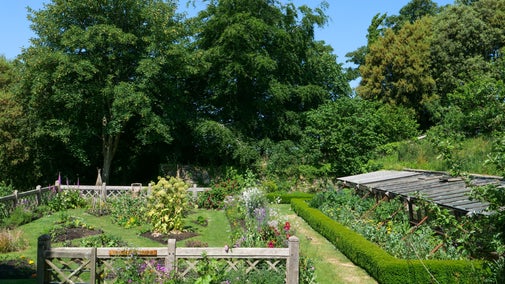
Donate
Everyone needs nature, now more than ever. Donate today and you could help people and nature to thrive at the places we care for.

Find out how our conservation team deep cleans the rooms and collection at Trerice every winter while the house is closed, and how our volunteer-led archaeology research group had success in finding an intriguing tunnel and 19th century courtyard in the garden.
Closing for the winter months gives the conservation team the opportunity to deep clean the rooms and collection at Trerice, ready for opening again in spring.
Using hip-vacs and pony-hair brushes they clean the house from top to bottom, taking photos and recording damage as they go.
Each item of furniture has its own custom cover and is cleaned before being covered for the closed months, while the historic windows are washed with cotton wool and distilled water.
This period also allows the team to get the more disruptive conservation work done. In 2018 new UV film was applied to some of the windows around the house. The UV film filters 99 per cent of harmful UV rays, working with conservation blinds to minimise light damage to the collection.
Though the house is closed there are some inevitable visitors that always make it through the doors: insects! The conservation team use this time to check all the traps and keep record of what kind of creepy-crawlies have been scuttling through Trerice, and intervening when necessary. Some, like woodlice, are less of a threat but bugs like silverfish need to be controlled as they damage paper.
The chough flag, part of a collection of Newquay home guard memorabilia at Trerice, has been restored. The flag was strengthened where necessary and framed to join other memorabilia on display in the morning room.
Meanwhile the garden team begin planting bulbs for spring in early November. 2000 bulbs, including daffodils, snowdrops, bluebells, tulips and alliums are planted with 15 tonnes of mulch to control the weeds and add some nutrients to the soil.

2017 was an exciting year for the volunteer-led Trerice Archaeological Research Group (TARG) team, as they conducted digs over a test pit weekend and the week-long ‘Big Mill Dig’ in September.
Two of the five test pits dug over a sunny July weekend were deemed particularly successful, finding a flagged floor and lintel in one and the corner of the 19th century courtyard in another.
In the September dig there were three main trenches dug below the barn where the team believed they might find a watermill. Evidence suggested that, on a property like Trerice, there should be one roughly in the area of the manor house and demesne (an area set aside by the lord of the manor for their own use).
The team found and excavated part of the courtyard farm that began to show on maps from the 1850s, correlating with the Tremaine family’s time at Trerice, meaning the team were able to better visualise Trerice during their tenure.
Further south-west of the barn was a trench in which the team found a poured concrete building with a packed earth floor and rubble deposit. The team found a crack in slabs of stone nearby and, looking through it, saw water reflected back up. The slabs were lifted to reveal a hole filled with standing water and a tunnel heading towards the barn.

After finding the tunnel, naturally the team were keen to dig again and so in September 2018 they dug another four trenches: one at the point where the tunnel was found, one in the knot garden, another by the wall of the undercroft and a fourth in the rear court – hoping to learn more about the original structure of the manor house.
Unfortunately they were unsuccessful in finding traces of the historic north wing of the house but did, in their words, successfully find where it isn’t! They also found, alongside the barn, another ‘tunnel’ – this time much shorter and suspected to be a leat.
The tunnel is 43 metres long and six feet tall, beginning as masonry but soon changing to cut rock. It wouldn’t have been a quick or easy job to carve – early attempts to date the tunnel suggest it is hand-cut.
After 43 metres the tunnel meets a ‘man-made’ blockage. It had been blocked with intent, and a Tudor brick as well as a medieval mullion were included in the debris that fills the tunnel.
While the barn end of the tunnel had been filled with Tudor brick and historic masonry the other was filled with more recent rubble: a watering can, bottles of a 1950s soft drink and assorted scrap metal.
With your ongoing support, we're able to continue our vital conservation work. Thank you for helping to protect these special places.

Everyone needs nature, now more than ever. Donate today and you could help people and nature to thrive at the places we care for.

Find out which families inherited and lived at Trerice. Discover how money was gained through the Royal Court and who were absent landlords.

Explore inside the house to see decorative plasterwork and collection items including a large table, Cornish paintings and a 300-year-old clock.

Explore an Elizabethan-inspired knot garden and an orchard full of Cornish apple varieties. It’s a great place to spot wildlife.

Find out where to grab some refreshments, and buy gifts and souvenirs during your visit to Trerice.

We believe that nature, beauty and history are for everyone. That’s why we’re supporting wildlife, protecting historic sites and more. Find out about our work.

Read about our strategy, which focuses on restoring nature, ending unequal access and inspiring more people.